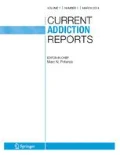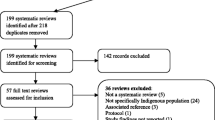Abstract
Introduction
This article reviews evidence-based smoking cessation and prevention programs for Indigenous youth and young adults in Australia, Canada, New Zealand, and the USA.
Methods
A systematic review using PubMed and PsycINFO search engines was conducted to identify randomized controlled trials (RCTs) and quasi-experimental studies focusing on Indigenous youth and young adults.
Results
Beyond two Cochrane reviews (2012) of smoking cessation and prevention programs for Indigenous youth and young adults, we located only two additional studies post Cochrane review. Combined results from the articles in the Cochrane reviews and the more recent studies suggest that recruitment of young Indigenous populations is challenging. Only one study with the smoking cessation program using mobile phone text messaging among the Maori was shown effective.
Conclusions
Additional evidence-based programs are essential for Indigenous youth and young adults to reduce smoking initiation and prevalence rates. Further evaluations of commercial tobacco use prevention and cessation programs are needed to bridge the gap between tobacco-related health disparities in Indigenous and non-Indigenous populations. Additionally, qualitative research is encouraged to further understand the barriers to recruitment.
Similar content being viewed by others
References
Papers of particular interest, published recently, have been highlighted as:• Of importance
First Nations Information Governance Centre. First Nations Regional Health Survey (RHS) 2008/10: National Report on adults, Youth and Children Living in First Nations Communities 2012. (Accessed 1/12/2018).
Statistics Canada. Aboriginal Peoples Survey, 2012 (89–653-X). (Accessed 1/12/2018).
Australian Bureau of Statistics: National Aboriginal and Torres Strait Islander social survey 2008. 2009, Canberra: Australian Bureau of Statistics (No. 4714.0).
Centers for Disease Control and Prevention (CDC) (2013). 1991–2013 High School Youth Risk Behavior Survey Data. Available at http://nccd.cdc.gov/youthonline/. Accessed on December 28, 2017.
Cass A. Health outcomes in aboriginal populations. CMAJ Can Med Assoc J. 2004;171(6):597–8. https://doi.org/10.1503/cmaj.1041059.
Azagba S, Baskerville NB, Minaker L. A comparison of adolescent smoking initiation measures on predicting future smoking behavior. Prev Med Rep. 2015;2:174–7. https://doi.org/10.1016/j.pmedr.2015.02.015.
Lemstra M, Rogers M, Thompson A, Moraros J, Tempier R. Prevalence and risk indicators of smoking among on-reserve first nations youth. Paediatr Child Health. 2011;16(10):e71–7.
Clark TT, Doyle O, Clincy A. Age of first cigarette, alcohol, and marijuana use among US biracial/ethnic youth: a population-based study. Addict Behav. 2013;38(9):2450–4. https://doi.org/10.1016/j.addbeh.2013.04.005.
Liu J, Zhao S, Chen X, Falk E, Albarracín D. The influence of peer behavior as a function of social and cultural closeness: a meta-analysis of normative influence on adolescent smoking initiation and continuation. Psychol Bull. 2017;143(10):1082–115. https://doi.org/10.1037/bul0000113.
Johnston V, Thomas DP. Smoking behaviours in a remote Australian indigenous community: the influence of family and other factors. Soc Sci Med. 2008;67(11):1708–16. https://doi.org/10.1016/j.socscimed.2008.09.016.
Kegler MC, Cleaver VL, Yazzie-Valencia M. An exploration of the influence of family on cigarette smoking among American Indian adolescents. Health Educ Res. 2000;15(5):547–57. https://doi.org/10.1093/her/15.5.547.
Samuel KA, Ribisl KM, Williams RS. Internet cigarette sales and native American sovereignty: political and public health contexts. J Public Health Policy. 2012;33(2):173–87. https://doi.org/10.1057/jphp.2012.4.
Unger JB, Soto C, Baezconde-Garbanati L. Perceptions of ceremonial and nonceremonial uses of tobacco by American-Indian adolescents in California. J Adolesc Health. 2006;38(4):443–9.
Carson KV, Brinn MP, Labiszewski NA, Peters M, Veale A, Esterman, A.J.& Smith, B. J. Interventions for tobacco use prevention in indigenous youth. Cochrane Database Syst Rev. 2012a;1:1–51.
Carson KV, Brinn MP, Peters M, Veale A, Esterman AJ, Smith BJ. Interventions for smoking cessation in indigenous populations. Cochrane Database Syst Rev. 2012b;1:1–32.
Cunningham C, Stanley F. Indigenous by definition, experience, or world view: links between people, their land, and culture need to be acknowledged. BMJ: Br Med J. 2003;327(7412):403–4. https://doi.org/10.1136/bmj.327.7412.403.
Bramley D, Riddell T, Whittaker R, Corbett T, Lin RB, Wills M, et al. Smoking cessation using mobile phone text messaging is as effective in Maori as non-Maori. N Zealand Med J. 2005;118(1216):1–10.
• Whittaker R, Dorey E, Bramley D, Bullen C, Denny S, Elley R, et al. A theory-based video messaging mobile phone intervention for smoking cessation: randomized controlled trial. J Med Internet Res. 2011;13(1):e10. A randomized controlled trial to test the effectiveness of a social cognitive theory based smoking cessation intervention among the Maori population. https://doi.org/10.2196/jmir.1553.
• Patten CA, Windsor RA, Renner CC, Enoch C, Hochreiter A, Nevak C, et al. Feasibility of a tobacco cessation intervention for pregnant Alaska Native women. Nicotine Tob Res. 2009;12(2):79–87. This is an important randomized two-group designed with assessments at baseline and during pregnancy.
Sussman S, Dent CW, Lichtman KL. Project EX: outcomes of a teen smoking cessation program. Addict Behav. 2001;26(3):425–38. https://doi.org/10.1016/S0306-4603(00)00135-0.
Morphett K, Partridge B, Gartner C, Carter A, Hall W. Why don’t smokers want help to quit? A qualitative study of smokers’ attitudes towards assisted vs. unassisted quitting. Int J Environ Res Public Health. 2015;12(6):6591–607. https://doi.org/10.3390/ijerph120606591.
Chamberlain et al. (2017) Evidence for a comprehensive approach to Aborginial tobacco control to maintain the decline in smoking: an overview of reviews among indigenous peoples. Systematic Reviews.
Choi WS, Beebe LA, Nazir N, Kaur B, Hopkins M, Talawyma M, et al. All nations breath of life: a randomized controlled trial of smoking cessation for American Indians. Am J Prev Med. 2016;51(5):743–51. https://doi.org/10.1016/j.amepre.2016.05.021.
DiGiamcomo et al. (2011) Smoking cessation in indigenous populations of Australia, New Zealand, Canada, and the United States: elements of effective interventions. International Journal of Environmental Research and Public Health.
Gnich W, Sheehy C, Amos A, Bitel M, Platt S. A Scotland-wide pilot programme of smoking cessation services for young people: process and outcome evaluation. Addiction. 2008;103(11):1866–74. https://doi.org/10.1111/j.1360-0443.2008.02316.x.
High School Youth Risk Behavior Survey 1991–2015, Centers for Disease Control and Prevention.
Minichiello et al. (2016) Effective strategies to reduce commercial tobacco use in indigenous communities globally: a systematic review. BMC Public Health.
Ministry of Health. Annual update of key results 2015/16: New Zealand health survey. Wellington: Ministry of Health; 2016. https://www.health.govt.nz/system/files/documents/publications/annual-update-key-results-2015-16-nzhs-dec16-v2.pdf
Paavola M, Vartiainen E, Puska P. Smoking cessation between teenage years and adulthood. Health Educ Res. 2001;16(1):49–57. https://doi.org/10.1093/her/16.1.49.
Stevenson et al. (2017) Establishing smoke-free homes in the indigenous populations of Australia, New Zealand, Canada and United States: a systematic lit review. Int J Environ Res Public Health.
Van der Sterren, A., Greenhalgh, EM., Knoche, D., & Winstanley, MH. (2016) 8.3 prevalence of tobacco use among aboriginal and Torres Strait islander people. Tobacco in Australia: Facts and issues. Melbourne: Cancer Council Victoria.
Author information
Authors and Affiliations
Corresponding author
Ethics declarations
Conflict of Interest
Claradina Soto, Jennifer B. Unger, Steve Sussman, and Ingrid Zeledon declare that they have no conflict of interest.
Human and Animal Rights and Informed Consent
This article does not contain any studies with human or animal subjects performed by any of the authors.
Additional information
This article is part of the Topical Collection on Tobacco
Rights and permissions
About this article
Cite this article
Soto, C., Unger, J.B., Sussman, S. et al. International Approaches to Tobacco Use Cessation Programming and Prevention Interventions among Indigenous Adolescents and Young Adults. Curr Addict Rep 5, 35–41 (2018). https://doi.org/10.1007/s40429-018-0186-y
Published:
Issue Date:
DOI: https://doi.org/10.1007/s40429-018-0186-y




